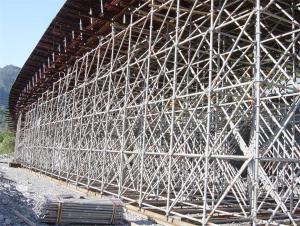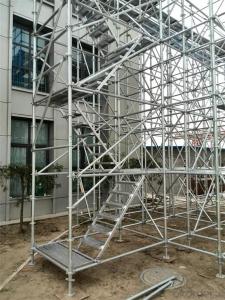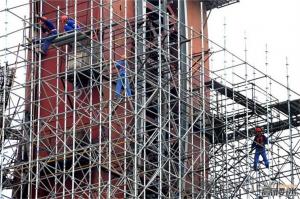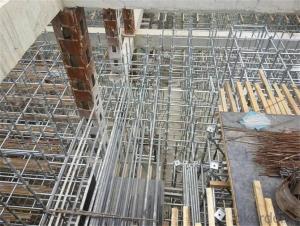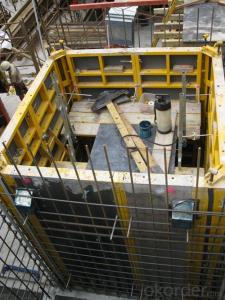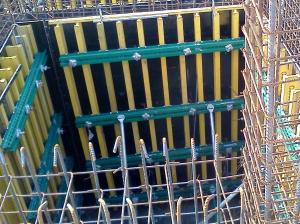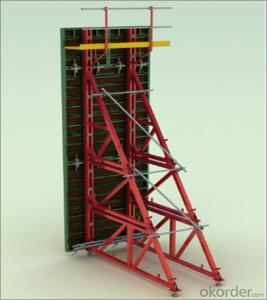RingLock Scaffolding with Hot or Cold Galvanized Surface
- Loading Port:
- Shanghai
- Payment Terms:
- TT OR LC
- Min Order Qty:
- 1000 m²
- Supply Capability:
- 100000 m²/month
OKorder Service Pledge
OKorder Financial Service
You Might Also Like
1.Structure of Ring lock Description
Ringlock Scaffolding system is the most popular used Scaffolding system in the world.It will greatly reduce the cost because of the following advantages
Packaging & Delivery
Packaging Details:
Pallet or bag or upon client's request
Delivery Detail:
35days
2.Main Features of Ringlock
It will greatly reduce the cost because of the following advantages
1)Using less pipes
2)Easy to install
3)It can be used again and again for nearly 20years
3.Ring lock product pictures:
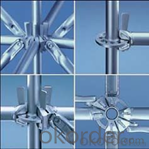
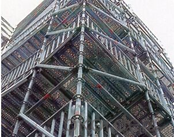
4.Ringlock Product Description
Type: ringlock scaffolding diagonal Brace
specification : Ø48.3×3.20
material:: steel Q235
Finished: Hot DIP galvanized, painted
Diagonal length(m) :Weight(kg)
0.9m * 1.25m 6.28
1.25m * 2.7m 11.45
5.FAQ
We have organized several common questions for our clients,may help you sincerely:
1)How about your company?
CNBM International Corporation, China National Building Materials (Group) Corporation, is one of the largest companies in China building material equipment industry, Our formwork and scaffolding are largely used in both domestic and all over world;
2)How many Scaffolding your company have?
Here comes our 5 types of Scaffolding systems:
- Cup lock Scaffolding(C-Lock Scaffolding)
- Ring lock Scaffolding
-Kwistage Scaffolding
-H-frame Scaffolding
-ID15 Scaffolding Tower, this type Scaffolding is the most widely used in construction, such like bridge.
3)How long can we receive the product after purchase?
Lead time is about 30days after getting the signed PI and deposit.
- Q:Can steel frame formwork be used in underground construction projects?
- Indeed, underground construction projects can make use of steel frame formwork. Steel frame formwork is a system that is both versatile and durable, making it a popular choice for a variety of construction applications, including underground projects. Its strength and rigidity enable it to withstand the pressures and forces commonly associated with underground construction. Typically constructed from high-quality steel, steel frame formwork offers excellent structural integrity and resistance to deformation. This quality makes it particularly well-suited for use in underground projects, where the soil and surrounding environment can exert increased levels of pressure. Furthermore, steel frame formwork provides flexibility in design and can be easily customized to meet the specific requirements of underground construction projects. Its adaptability allows for the creation of intricate shapes and structures, which are often necessary in underground constructions such as tunnels, subway systems, and basements. Another advantage of steel frame formwork is its reusability, which can lead to cost savings and reduced environmental impact in underground construction. The formwork can be effortlessly dismantled, relocated, and reassembled in different locations, making it an economical choice for projects that involve multiple construction phases. In conclusion, steel frame formwork is an ideal option for underground construction projects due to its strength, durability, flexibility, and reusability. It provides the necessary structural support and adaptability required to tackle the unique challenges associated with underground construction, making it a preferred choice for many engineers and contractors.
- Q:How does steel frame formwork contribute to the overall aesthetics of a structure?
- Steel frame formwork contributes to the overall aesthetics of a structure in several ways. Firstly, it allows for precise and accurate construction, ensuring that the structure is built according to the intended design. This results in clean lines, smooth surfaces, and consistent dimensions, which all contribute to a visually pleasing appearance. Additionally, steel frame formwork allows for flexibility in design. It can be easily customized and adapted to create various architectural shapes and forms, such as curves, angles, and intricate patterns. This versatility enables architects and designers to create unique and visually striking structures that stand out in their surroundings. Furthermore, steel frame formwork provides a high-quality finish to the concrete surfaces. The steel panels used in the formwork are usually smooth and durable, which ensures that the finished concrete will have a smooth and refined appearance. This is particularly important for structures where the exposed concrete is a prominent feature, such as in modern architectural designs. Moreover, steel frame formwork allows for efficient construction processes, which can contribute to the overall aesthetics of a structure. The use of steel formwork enables faster and more accurate construction, reducing the need for extensive on-site modifications and repairs. This results in a more streamlined construction process, minimizing disruptions and delays, and ultimately leading to a more visually appealing final outcome. In summary, steel frame formwork plays a significant role in enhancing the overall aesthetics of a structure. Its precision, flexibility in design, high-quality finish, and efficient construction processes all contribute to creating visually pleasing and architecturally impressive buildings.
- Q:How does steel frame formwork affect the overall safety of workers during concrete pouring and curing?
- Steel frame formwork can significantly enhance the overall safety of workers during concrete pouring and curing. Its sturdy and robust construction provides stability and support to the concrete structure, reducing the risk of collapse or accidents. Steel frame formwork also allows for precise and controlled concrete placement, preventing any potential hazards caused by uneven pouring. Additionally, its durability ensures a secure working environment, minimizing the chances of accidents and injuries associated with formwork failure. Overall, the use of steel frame formwork enhances worker safety by providing a reliable and stable structure during concrete pouring and curing processes.
- Q:What are the different types of formwork pins used with steel frame formwork systems?
- There are several types of formwork pins commonly used with steel frame formwork systems, including flat head pins, wedge pins, pin and wedge systems, and snap tie pins. Each type serves a specific purpose in securely connecting and aligning the formwork panels, ensuring stability and accuracy during the concrete pouring process.
- Q:Can steel frame formwork be used for airport and transportation infrastructure construction?
- Yes, steel frame formwork can be used for airport and transportation infrastructure construction. Steel frame formwork is a versatile and durable construction system that can be used for various types of projects, including large-scale infrastructure projects like airports and transportation facilities. Steel frame formwork provides a strong and stable structure for pouring concrete, ensuring that the resulting construction is sturdy and able to withstand the demands of heavy traffic and frequent use. The steel frames can be easily assembled and disassembled, allowing for efficient construction and minimizing downtime. Additionally, steel frame formwork offers flexibility in design and can be customized to meet specific project requirements. This is particularly important for airport and transportation infrastructure construction, as these facilities often have unique architectural and structural requirements. Furthermore, steel frame formwork is highly durable and can withstand the harsh conditions associated with airports and transportation infrastructure, such as extreme weather conditions and heavy loads. This makes it an ideal choice for long-lasting and reliable construction in these sectors. Overall, steel frame formwork is a suitable option for airport and transportation infrastructure construction due to its strength, versatility, and durability. It offers the necessary structural support and flexibility required for these types of projects, ensuring the successful completion of high-quality and resilient facilities.
- Q:Can steel frame formwork be used for both residential and industrial construction?
- Yes, steel frame formwork can be used for both residential and industrial construction. The durability and strength of steel make it suitable for various construction projects, including both residential and industrial buildings. Steel frame formwork offers stability and can withstand heavy loads, making it a versatile choice for different types of construction.
- Q:Can steel frame formwork be used for both temporary and permanent concrete structures?
- Yes, steel frame formwork can be used for both temporary and permanent concrete structures. Steel frame formwork is a versatile and durable system that is capable of withstanding the pressures and forces exerted during the concrete pouring process. It provides a stable and secure framework for pouring and shaping the concrete, ensuring accurate dimensions and a high-quality finish. For temporary structures, steel frame formwork can be easily assembled and disassembled, allowing for quick and efficient construction. It is commonly used for projects such as bridges, tunnels, and temporary structures like staging platforms. Once the concrete has cured, the formwork can be dismantled and reused for other projects. For permanent structures, steel frame formwork can also be utilized. Its strength and durability make it suitable for long-term use, especially in projects where the formwork needs to remain in place to support the structure. Steel formwork can withstand the weight and pressure of the concrete, providing the necessary support until the structure reaches its full strength. However, it is important to note that steel frame formwork may require additional protection or surface treatment for permanent structures to prevent corrosion and ensure long-term durability. This can be achieved through various methods such as applying protective coatings or using corrosion-resistant materials. In conclusion, steel frame formwork is a versatile solution that can be used for both temporary and permanent concrete structures. Its strength, durability, and ease of use make it a popular choice for construction projects of all scales.
- Q:Can steel frame formwork be used for heavy-duty industrial structures?
- Yes, steel frame formwork can be used for heavy-duty industrial structures. Steel frame formwork is a robust and durable system that can withstand the high loads and pressures associated with heavy-duty structures. It offers excellent strength and stability, making it suitable for constructing large-scale industrial buildings, such as warehouses, factories, and power plants. The steel frame formwork system can be customized and adjusted to meet the specific requirements of each project, ensuring the construction of a reliable and sturdy structure. Additionally, steel frame formwork allows for faster construction compared to traditional methods, resulting in cost and time savings for the project.
- Q:What are the different types of edge protection systems used with steel frame formwork?
- There are several types of edge protection systems that can be used with steel frame formwork to ensure the safety of workers and prevent falls or accidents. These systems are designed to create a barrier or guardrail around the edges of the formwork, providing a secure working environment. One type of edge protection system commonly used with steel frame formwork is the handrail system. This system consists of metal or plastic handrails that are attached to the frame of the formwork. The handrails act as a barrier, preventing workers from accidentally falling off the edges of the formwork. Handrail systems are typically easy to install and can be adjusted to fit different formwork configurations. Another type of edge protection system is the toe board system. Toe boards are horizontal barriers that are installed along the bottom edge of the formwork. They are designed to prevent tools, materials, or debris from falling off the formwork and potentially injuring workers below. Toe boards are usually made of metal or wood and can be easily attached to the frame of the formwork. Additionally, some edge protection systems include mesh panels or safety nets. These systems provide a physical barrier around the edges of the formwork, preventing workers from accidentally falling off. Mesh panels or safety nets are usually made of strong, durable materials and are securely attached to the frame of the formwork. They can be easily installed and removed as needed. Lastly, some edge protection systems include a combination of handrails, toe boards, and mesh panels or safety nets. These comprehensive systems offer multiple layers of protection and are often used in larger construction projects or areas with higher risks of falls or accidents. Overall, the different types of edge protection systems used with steel frame formwork serve the common purpose of ensuring worker safety and preventing falls or accidents. The specific type of system used will depend on the requirements of the project and the level of protection needed.
- Q:Are there any limitations on the height of structures that can be constructed using steel frame formwork?
- The construction of structures using steel frame formwork is subject to certain limitations when it comes to height. The primary factors that influence these limitations include the design, engineering considerations, and the capabilities of the steel frame formwork system being utilized. A crucial aspect that can restrict the height is the capacity of the steel frame formwork to bear loads. It must be capable of supporting the weight of the concrete as well as any additional loads such as construction equipment or workers. Should the height surpass the formwork's load-bearing capacity, it may lead to structural instability and potential collapse. Furthermore, the stability and rigidity of the steel frame formwork system play a vital role in determining the maximum height. As the height increases, the formwork system must withstand lateral forces, wind loads, and other external factors that can impact the structure's stability. Failure to account for these forces in the formwork's design compromises the construction's safety and integrity. In addition, the availability of suitable equipment and technology can impose restrictions on the height of structures constructed using steel frame formwork. Taller structures may necessitate specialized equipment, such as high-capacity cranes or lifting systems, for the assembly and dismantling of the formwork. If such equipment is unavailable or impractical, it limits the height achievable with steel frame formwork. Lastly, local building codes and regulations also dictate the maximum height of structures. These regulations exist to guarantee the safety and stability of buildings and prevent potential risks to the surrounding environment. It is imperative to adhere to these regulations and obtain appropriate permits when constructing tall structures using steel frame formwork. To conclude, while steel frame formwork offers versatility and strength in construction, there are limitations on the height of structures that can be constructed using this system. Factors such as load-bearing capacity, stability, equipment availability, and local regulations determine the maximum achievable height. It is crucial to consult experienced engineers and adhere to safety guidelines to ensure the successful construction of tall structures using steel frame formwork.
1. Manufacturer Overview |
|
|---|---|
| Location | |
| Year Established | |
| Annual Output Value | |
| Main Markets | |
| Company Certifications | |
2. Manufacturer Certificates |
|
|---|---|
| a) Certification Name | |
| Range | |
| Reference | |
| Validity Period | |
3. Manufacturer Capability |
|
|---|---|
| a)Trade Capacity | |
| Nearest Port | |
| Export Percentage | |
| No.of Employees in Trade Department | |
| Language Spoken: | |
| b)Factory Information | |
| Factory Size: | |
| No. of Production Lines | |
| Contract Manufacturing | |
| Product Price Range | |
Send your message to us
RingLock Scaffolding with Hot or Cold Galvanized Surface
- Loading Port:
- Shanghai
- Payment Terms:
- TT OR LC
- Min Order Qty:
- 1000 m²
- Supply Capability:
- 100000 m²/month
OKorder Service Pledge
OKorder Financial Service
Similar products
New products
Hot products
